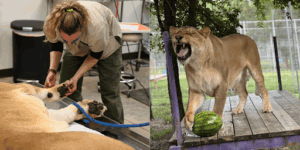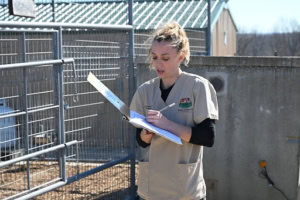September is Animal Pain Awareness Month. The International Veterinary Academy of Pain Management (IVAPM) declared this month of awareness. Its purpose is to bring awareness to understanding and recognizing pain that animals can experience. Pain can be harder to notice and understand in animals than it is in humans since they do not communicate with us verbally. It is our job as the keepers of the animals at Turpentine Creek Wildlife Refuge to understand and treat any pain they may experience in order to give them the best life possible since their rescues.
Types of Pain
Pain can be categorized several ways. Acute pain is temporary. It typically occurs due to an injury and goes away when the injury is healed, such as a broken bone or a cut on the skin. Chronic pain occurs when an injury or condition takes longer to heal, and sometimes never does, such as arthritis pain.
Pain can be even further categorized based on where it originates. Somatic pain is pain that originates from bones, muscles, skin, and tendons. Visceral pain is from internal organs. Nerve pain comes from the brain, nerves, and spinal cord. Understanding the type of pain an animal is experiencing and where it is originating from is vital in order to treat the issue and relieve the pain.
Things We Look For
TCWR is currently home to over 110 animals. We keep an eye on every single one, both when they arrive and after. The animals that are rescued and make their way to TCWR often arrive suffering from some sort of pain. This can be from lack of proper nutrition that causes their bones to weaken, being declawed, cuts or scratches, broken ribs, hernias, cancers, arthritis from old age, and all sorts of other ailments. Our veterinarian will examine these animals and provide a treatment plan for them and their pain. This treatment plan will continue until the ailment is healed and the pain is gone.
Sometimes, however, the ailment never heals and the pain is chronic. These animals will be on a pain management plan for the rest of their lives in order to provide them with a comfortable life at TCWR. If their condition changes even slightly, we revise their treatment plan to fit their needs.

Indicators of Pain
There are times when an animal that has been at TCWR for a while and has been healthy might start to show indicators of pain. An obvious indicator of pain could be a cut or scratch. This can happen if they share a habitat with another animal and there is a minor dispute. Another obvious indicator of pain would be a new or worsening limp. Other indicators can be frequent urination, licking a specific area often, inability to pass a bowel movement or changes in bowel movements, lethargy, decreased food and water consumption, increased fear, and increased aggression. These are just some of the things we look out for. If our staff or interns notice any of these things, they report it at the end of the work day to make our animal curator and veterinarian aware.

The Next Steps
When it is noticed that an animal is experiencing pain, our veterinarian will often start them on medication, such as a non-steroidal, anti-inflammatory drug like Meloxicam. Our Animal Care team will monitor them, and if things do not seem to be improving, they will sedate them and take them to our vet hospital for a medical exam. Depending on the results of the exam, we will go from there. Of course, each animal at TCWR is provided with care specific to their own needs. Therefore, treatment plans can vary and change over time.
If you are interested in visiting our veterinary hospital and learning more about our exam room and pain management program, we offer specialty tours. Take the Carnivore Caravan Tour or the Coffee with the Curator Tour to learn more!
Sources
https://www.ivapm.org/animal-pain-awareness-month
https://www.awrc.org.au/uploads/5/8/6/6/5866843/dr_anne_fowler-recognition_of_pain_in_wildlife.pdf
*Published by Danika Torgersen on 09/13/2025*